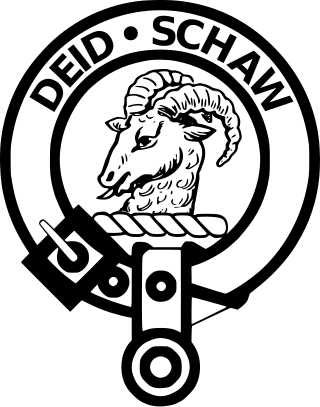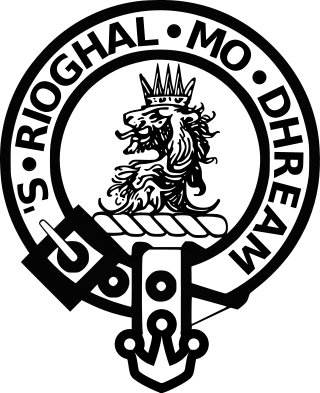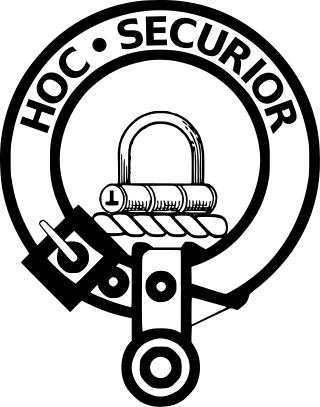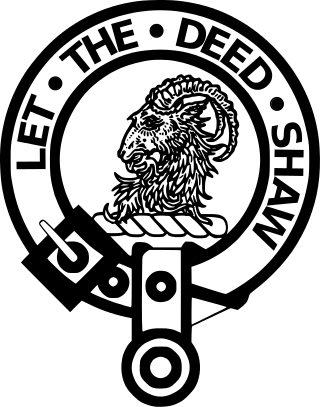
Clan Fergusson is a Scottish clan. Known as the Sons of Fergus they have spread across Scotland from as far as Ross-shire in the north to Dumfriesshire in the south.

Clan Farquharson is a Highland Scottish clan based at Invercauld and Braemar, Aberdeenshire, and is a member of the Chattan Confederation.

The Clan Ruthven is a Lowland Scottish clan.

Clan Gregor, also known as Clan MacGregor, is a Highland Scottish clan that claims an origin in the early 9th century. The clan's most famous member is Rob Roy MacGregor of the late 17th and early 18th centuries. The clan is also known to have been among the first families of Scotland to begin playing the bagpipes in the early 17th century.

Clan Colquhoun is a Highland Scottish clan.

Clan Drummond is a Highland Scottish clan. The surname is rendered "Druimeanach" in modern Scottish Gaelic.

Clan Lamont is a Highland Scottish clan. The clan is said to descend from Ánrothán Ua Néill, an Irish prince of the O'Neill dynasty, and through him Niall Noigíallach, High King of Ireland. Clan Ewen of Otter, Clan MacNeil of Barra, Clan Lachlan, and Clan Sweeney are also descendants of Ánrothán. Traditional genealogy would therefore include Clan Lamont among the descendants of Conn Cétchathach.

Clan Macnab is a Highland Scottish clan.

Clan Erskine is a Scottish clan of the Scottish Lowlands.

Clan Ogilvy, also known as Clan Ogilvie, is a Highland Scottish clan. Originating from Angus, Scotland, the progenitor of the Clan received a barony from King William the Lion in 1163. In 1491, King James IV elevated Sir James Ogilvy as Lord Ogilvy of Airlie.

Clan MacLaren is a Highland Scottish clan. Traditional clan lands include the old parish of Balquhidder which includes the villages of Lochearnhead and Strathyre, and is about 18 miles (29 km) long and 7 miles (11 km) broad, spanning 54,675 acres (22,126 ha), long known as "Maclaren Country".

Clan Moncreiffe is a Highland Scottish clan.

Clan Grierson is a Lowlands Scottish Clan.

Clan Kirkpatrick is a Lowland armigerous Scottish clan. There are several variations of the Kirkpatrick name: Kilpatric, Kilpatrick, and Gilpatrick. The names Kirkpatrick and Kilpatrick may have been interchangeable at one time. The clan is recognised by the Court of the Lord Lyon, however the clan does not currently have a chief so recognised. The surname Kirkpatrick is also a recognized sept of Clan Douglas and Clan Colquhoun.

Clan Cumming, historically known as Clan Comyn, is a Scottish clan from the central Highlands that played a major role in the history of 13th-century Scotland and in the Wars of Scottish Independence. The Clan Comyn was once the most powerful family in 13th-century Scotland, until they were defeated in civil war by their rival to the Scottish throne, Robert the Bruce.

The siege of Blair Castle was a conflict that took place in Scotland in March 1746 and was part of the Jacobite rising of 1745. It was fought between Scottish forces loyal to the British-Hanoverian government of George II of Great Britain, which defended Blair Castle near the village of Blair Atholl in Perthshire, and Scottish Jacobite forces loyal to the House of Stuart.

Clan Fleming is a Lowland Scottish clan and is officially recognized as such by the Lord Lyon King of Arms. However, as the clan does not currently have a chief that is recognized by the Lord Lyon King of Arms it is therefore considered an armigerous clan.
Clan Paterson is a Lowland Scottish clan. The clan is officially recognized as such by the Lord Lyon King of Arms; however, as the clan does not currently have a chief it is considered an Armigerous clan.

John Murray, 1st Earl of Tullibardine was a Scottish courtier and leader of the Clan Murray.


















